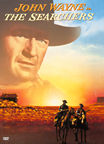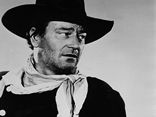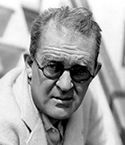The Searchers: A Look Back

Recently, I had the opportunity of seeing John Ford’s great classic Western, The Searchers. I hadn’t seen it for many years and I found myself still riveted by the epic sweep of the story and the visual splendor of Monument Valley, perhaps Ford’s favorite location.
John Wayne plays a former officer in the Confederacy, Ethan Edwards, who returns home a few years after the Civil War to find his family massacred and his niece kidnapped by a renegade band of Comanches. Ethan vows his revenge and begins an obsessive hunt to find his niece (Natalie Wood). But his search, begun as an heroic adventure, soon turns into a dark and obsessive manhunt.
My image of John Wayne has always been as the classic western hero, strong, rugged, silent, following a code of honor and moral behavior that represents all the best virtues of the old West. Wayne’s screen image is a mythic, heroic figure determinedly following his path to achieve what is right, noble and just, while still remaining true to his beliefs. The Searchers starts out this way, and it’s pretty clear that the search is what defines his life and gives it meaning.
 It didn’t take long for me to see that the character of Ethan Edwards is different than most of the other parts John Wayne plays, whether in Stagecoach, Red River, She Wore a Yellow Ribbon or Fort Apache. In The Searchers, Ethan Edwards is a person who doesn’t belong anywhere, the outsider, a man doomed to “wander on the wind.” As the story unfolds, the thin line between obsession and revenge, the opposite poles of “civilization” and “wilderness” become totally blurred.
It didn’t take long for me to see that the character of Ethan Edwards is different than most of the other parts John Wayne plays, whether in Stagecoach, Red River, She Wore a Yellow Ribbon or Fort Apache. In The Searchers, Ethan Edwards is a person who doesn’t belong anywhere, the outsider, a man doomed to “wander on the wind.” As the story unfolds, the thin line between obsession and revenge, the opposite poles of “civilization” and “wilderness” become totally blurred.
Ethan begins the search for his kidnapped niece as an agent of civilization performing a heroic and humanitarian task. But as time passes, we see by his actions that he seems more aligned with the forces of darkness than civilization. His obsession takes over and he refuses to listen to reason or his own inherent humanity. In the beginning we think it’s Ethan’s honor that drives him, a form of revenge for the massacre of his loved ones, but as time passes we learn he’s a racist who wants to find his niece only to kill her. She has become “spoiled,” a squaw, unfit to be in a “white” family, as she must now be “tainted” with the blood of the Comanches.
What I found so interesting is that the film mirrors the racial tensions going on in America at the time the film was made, 1956. It was the start of the Civil Rights Movement, and Ethan’s obsessive quest seems to parallel the times in Hollywood when the Hollywood Blacklist was in effect. This horrific witch hunt took its toll on the lives and careers of professional people who were forced to test their honor and integrity. The Hollywood Ten spent a year in prison as the principles of self-respect, artistic freedom, became the rallying cries of the screenwriters who were suffering from the outrage and indignities of this period.
 Director John Ford |
I think this is the first time I can recall a film portraying the traditional Western hero in a critical light. By the same token, the Native American point of view is edged with understanding and humanity. By balancing these two poles between the two poles of civilization and wilderness, the heroic and obsessive, John Ford deepens the tensions and characterizations in the movie.
Ethan’s obsession is what drives him relentlessly to search for his niece. For 7 years, Ethan trails the renegades, never giving up, driven by his fixation to kill and avenge the death of his family.
As I watched Ethan’s quest, I thought his journey might have been derived from the work of Joseph Campbell. Campbell had reached back through time, memory and culture to collect a series of myths from the ancient, primitive and contemporary traditions, culling them into a basic form which he termed “the heroes journey.” Campbell found that in almost all myths and cultures, from ancient times to modern, the hero travels along the same path and reaches the same destination; enlightenment and realization. As the hero follows this path, he encounters various obstacles that test the nature of his resolve and serve to elevate him to a higher level of consciousness and understanding, a new level of being.
While I was watching The Searchers, I tried to relate Campbell’s concepts to Ethan’s journey. Though Ethan is placed in a situation where he confronts a series of obstacles in order to achieve a higher state of consciousness, he refuses to bend his principles, or his beliefs, to the issue at hand. His journey is both a physical as well as spiritual one, because it takes place inside his head as well as outside in the obstacles he confronts. In Campbell’s work, the hero in his journey experiences a symbolic transformation of death and resurrection as he casts off the old parts of his life; he needs to be re-born and emerge into the “birth” of his new self. In mythological terms, Campbell says, the heroes’ journey is one of acceptance; the hero must accept his fate, his destiny, no matter whether it is life or death.
This is not the case in The Searchers.

In Campbell’s analysis, the hero weathers every obstacle but returns home a wiser and better person, sharing his newfound awareness with his fellow man. That certainly doesn’t happen in The Searchers. At the end of The Searchers, it is his very strength of character that leads to his isolation and loneliness. In comparing it to other films of the period, this is the start of the “anti-hero,” the character who goes his own way even though it may be against the laws of society.
What makes this film a classic, I think, is that the traditional moral lines of good and bad, or right and wrong, and black and white, are blurred. It’s is a tribute to Ford’s genius that he could combine both the look and feel of an epic Western, as well as reflect the social nature of the times and the very ambiguity of the changing times.


Comments are closed.